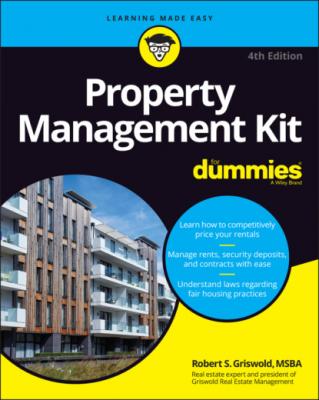Property Management Kit For Dummies. Robert S. Griswold
Чтение книги онлайн.
Читать онлайн книгу Property Management Kit For Dummies - Robert S. Griswold страница 13
 your texts, emails, or phone calls to actual property visits is the next essential step to creating maximum interest in your rental unit. Chapter 9 explains how to get prospective tenants to view your property.
your texts, emails, or phone calls to actual property visits is the next essential step to creating maximum interest in your rental unit. Chapter 9 explains how to get prospective tenants to view your property.
The best result you can expect to achieve at the property-viewing stage is persuading the prospect to complete your rental application and put down a holding deposit. What the prospect can expect from you at this time is the receipt of all of the very important mandatory disclosures.
Picking your tenants and signing the deal
Property management isn’t exactly like an online dating game, but you do want to gather information (while following all fair-housing laws to the letter, as covered in Chapter 11) and select a tenant who meets or exceeds your minimum written rental qualification standards. Tenant selection is probably the single step in the rental process that can make or break you as a property manager, so I devote a lot of detail to this important topic in Chapter 11.
Getting Your Hands Dirty: Managing the Property
You never hear from your tenants, yet the check seems to come in the mail each month. Managing your rental unit seems easy — just like you pushed a button! But after a year of progressively bursting with pride at your exceptional property management skills, you decide to drive by the property, only to find that your retirement plans and financial nest egg are candidates for a remake of Animal House!
In the next sections, I present the practical, in-the-trenches part of property management that can help you get familiar with every day-to-day eventuality related to the operational side of property management and the life cycle of a tenancy.
Moving tenants in and out
Coordinating the move-in of a new tenant is one of your most pleasant tasks, because this time is your best opportunity to ensure that your tenant starts out on the right foot by explaining your rental rules and guidelines. Chapter 12 helps ensure that your move-in process runs smoothly.
But all good things must come to an end. That end should start with your making sure that the move-out date is mutually agreed-on in writing and that the tenant understands your expectations, policies, and procedures through a tenant move-out information letter. I share more information about making the move-out process as painless as possible for everyone involved in Chapter 16.
Collecting rent
You can greatly improve your chances of making the rent collection process a positive experience by emphasizing your collection policy when your tenant first moves in and by answering for your new tenant all the who, what, when, where, and how questions they may have about their rent payments you collect.
But no matter how carefully you screen your tenants and how thoroughly you explain your rent collection policy, sometimes the inevitable happens, and your tenant is unable to pay the full rent when it’s due. What do you do? Start by issuing reasonable but firm policies when the tenant moves in and enforcing your grace period and late-period policies. Then, if your tenant doesn’t pay the rent or doesn’t live up to their responsibilities under the rental contract, you’re prepared to take the appropriate legal action to regain possession of your property as quickly as possible. Chapter 13 provides more in-depth info to help you collect rent.
Keeping the good tenants
Turnover is your number-one nemesis as a rental property owner. Although it’s inevitable, your ability to renew your leases and provide incentives for your tenants to stay and pay can be significant in controlling your expenses and maximizing your rental income. That’s why keeping your tenants — particularly your good tenants — is a smart move.
Dealing with troublesome tenants
Despite your best tenant-screening efforts, you’re going to make the wrong decision at some point and allow a problem tenant to move in, or you’ll have a good tenant who turns sour. But you can lessen the number of these incidents by getting to know some of the problems you may encounter and how to deal with them early on:
Late or missed rent payments: Timely payment of rent is the lifeblood of real estate investing, because you can’t pay your mortgage or expenses without it. A written rent collection policy is a valuable tool for minimizing these problems. You also need to know about any government or private financial resources available to your tenant to help them pay the past-due rent, as most courts in a post-pandemic environment are less likely to enforce an eviction until all such resources are considered.
Loud tenants: It takes only one boisterous tenant to disrupt the tranquility of the whole neighborhood and destroy your tenants’ right to “quiet enjoyment.” Developing and implementing rental policies and rules can prevent your problem tenant from chasing the good tenants away. At many properties, the one bad apple is the reason why more of the good-apple tenants leave than any other single issue. So don’t underestimate the importance to your cash flow of removing disruptive tenants in a timely and legally allowed manner.
Chapter 15 gives you some additional tools for dealing with problem tenants effectively. I also